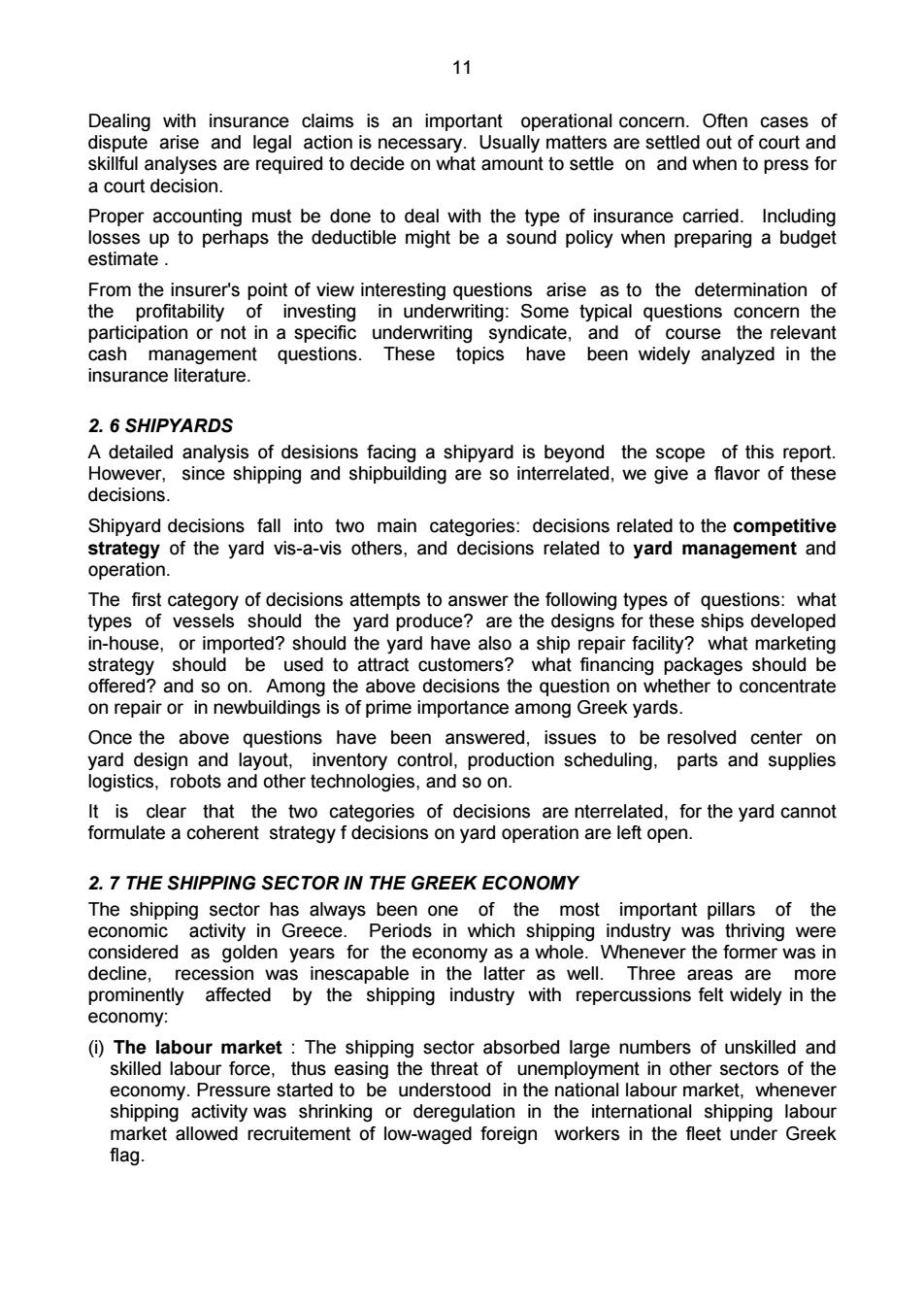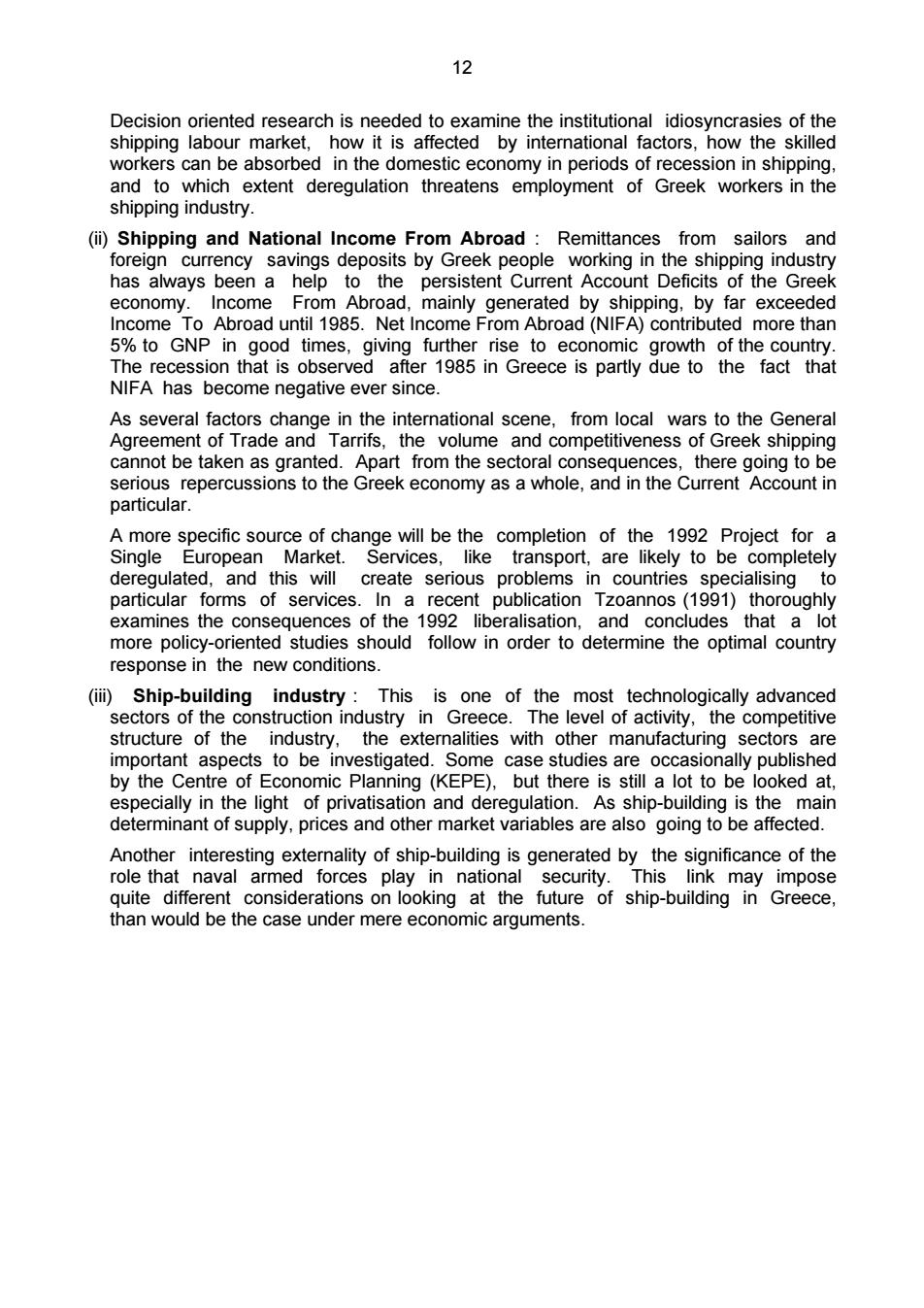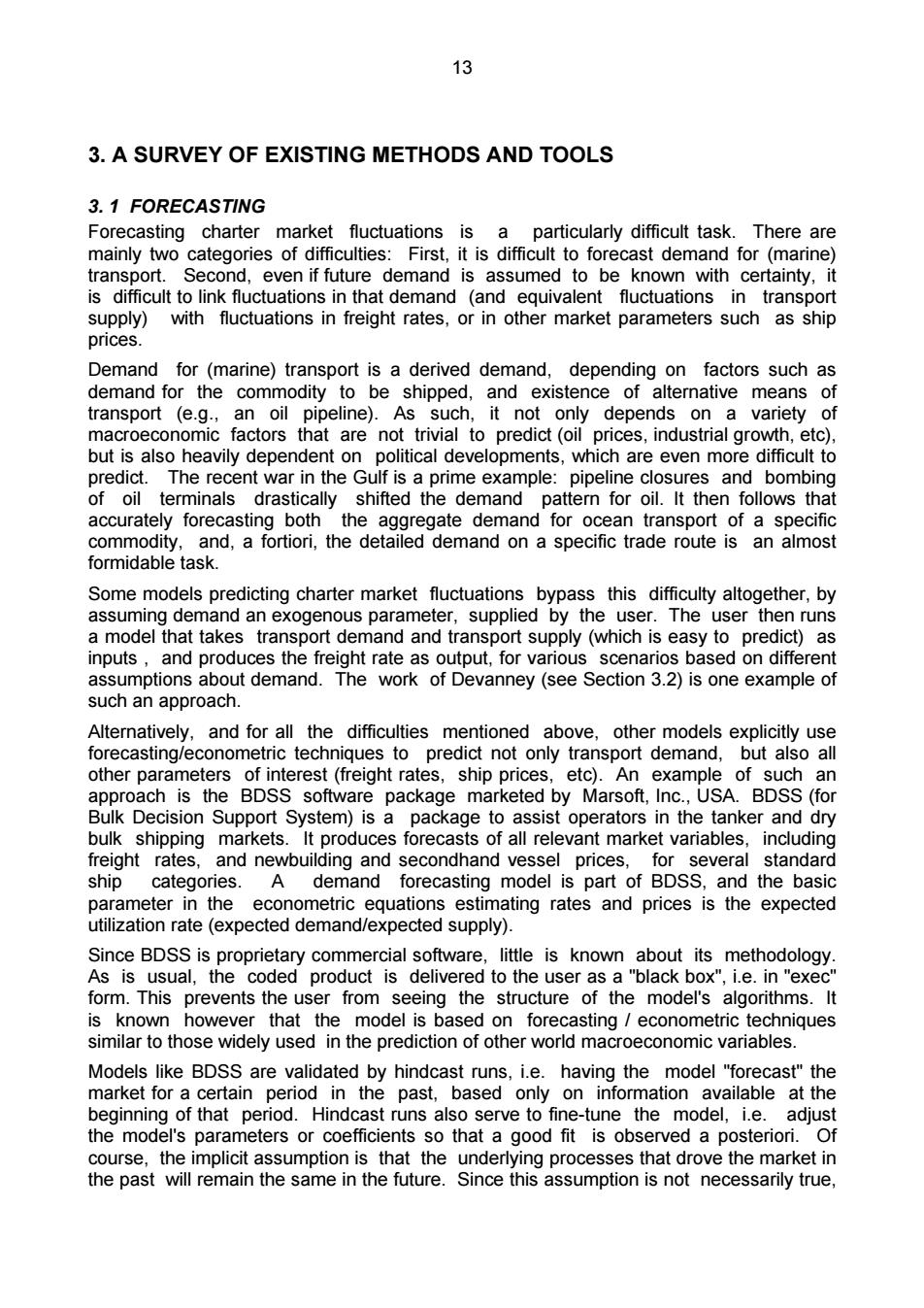
11 Dealing with insurance claims is an important operational concern.Often cases of dispute arise and legal action is necessary.Usually matters are settled out of court and skillful analyses are required to decide on what amount to settle on and when to press for a court decision. Proper accounting must be done to deal with the type of insurance carried.Including losses up to perhaps the deductible might be a sound policy when preparing a budget estimate. From the insurer's point of view interesting questions arise as to the determination of the profitability of investing in underwriting:Some typical questions concern the participation or not in a specific underwriting syndicate,and of course the relevant cash management questions.These topics have been widely analyzed in the insurance literature. 2.6 SHIPYARDS A detailed analysis of desisions facing a shipyard is beyond the scope of this report. However,since shipping and shipbuilding are so interrelated,we give a flavor of these decisions. Shipyard decisions fall into two main categories:decisions related to the competitive strategy of the yard vis-a-vis others,and decisions related to yard management and operation. The first category of decisions attempts to answer the following types of questions:what types of vessels should the yard produce?are the designs for these ships developed in-house,or imported?should the yard have also a ship repair facility?what marketing strategy should be used to attract customers?what financing packages should be offered?and so on.Among the above decisions the question on whether to concentrate on repair or in newbuildings is of prime importance among Greek yards. Once the above questions have been answered,issues to be resolved center on yard design and layout,inventory control,production scheduling,parts and supplies logistics,robots and other technologies,and so on. It is clear that the two categories of decisions are nterrelated,for the yard cannot formulate a coherent strategy f decisions on yard operation are left open. 2.7 THE SHIPPING SECTOR IN THE GREEK ECONOMY The shipping sector has always been one of the most important pillars of the economic activity in Greece.Periods in which shipping industry was thriving were considered as golden years for the economy as a whole.Whenever the former was in decline,recession was inescapable in the latter as well.Three areas are more prominently affected by the shipping industry with repercussions felt widely in the economy: (i)The labour market The shipping sector absorbed large numbers of unskilled and skilled labour force,thus easing the threat of unemployment in other sectors of the economy.Pressure started to be understood in the national labour market,whenever shipping activity was shrinking or deregulation in the international shipping labour market allowed recruitement of low-waged foreign workers in the fleet under Greek flag
11 Dealing with insurance claims is an important operational concern. Often cases of dispute arise and legal action is necessary. Usually matters are settled out of court and skillful analyses are required to decide on what amount to settle on and when to press for a court decision. Proper accounting must be done to deal with the type of insurance carried. Including losses up to perhaps the deductible might be a sound policy when preparing a budget estimate . From the insurer's point of view interesting questions arise as to the determination of the profitability of investing in underwriting: Some typical questions concern the participation or not in a specific underwriting syndicate, and of course the relevant cash management questions. These topics have been widely analyzed in the insurance literature. 2. 6 SHIPYARDS A detailed analysis of desisions facing a shipyard is beyond the scope of this report. However, since shipping and shipbuilding are so interrelated, we give a flavor of these decisions. Shipyard decisions fall into two main categories: decisions related to the competitive strategy of the yard vis-a-vis others, and decisions related to yard management and operation. The first category of decisions attempts to answer the following types of questions: what types of vessels should the yard produce? are the designs for these ships developed in-house, or imported? should the yard have also a ship repair facility? what marketing strategy should be used to attract customers? what financing packages should be offered? and so on. Among the above decisions the question on whether to concentrate on repair or in newbuildings is of prime importance among Greek yards. Once the above questions have been answered, issues to be resolved center on yard design and layout, inventory control, production scheduling, parts and supplies logistics, robots and other technologies, and so on. It is clear that the two categories of decisions are nterrelated, for the yard cannot formulate a coherent strategy f decisions on yard operation are left open. 2. 7 THE SHIPPING SECTOR IN THE GREEK ECONOMY The shipping sector has always been one of the most important pillars of the economic activity in Greece. Periods in which shipping industry was thriving were considered as golden years for the economy as a whole. Whenever the former was in decline, recession was inescapable in the latter as well. Three areas are more prominently affected by the shipping industry with repercussions felt widely in the economy: (i) The labour market : The shipping sector absorbed large numbers of unskilled and skilled labour force, thus easing the threat of unemployment in other sectors of the economy. Pressure started to be understood in the national labour market, whenever shipping activity was shrinking or deregulation in the international shipping labour market allowed recruitement of low-waged foreign workers in the fleet under Greek flag

12 Decision oriented research is needed to examine the institutional idiosyncrasies of the shipping labour market,how it is affected by international factors,how the skilled workers can be absorbed in the domestic economy in periods of recession in shipping, and to which extent deregulation threatens employment of Greek workers in the shipping industry. (ii)Shipping and National Income From Abroad Remittances from sailors and foreign currency savings deposits by Greek people working in the shipping industry has always been a help to the persistent Current Account Deficits of the Greek economy.Income From Abroad,mainly generated by shipping,by far exceeded Income To Abroad until 1985.Net Income From Abroad(NIFA)contributed more than 5%to GNP in good times,giving further rise to economic growth of the country. The recession that is observed after 1985 in Greece is partly due to the fact that NIFA has become negative ever since. As several factors change in the international scene,from local wars to the General Agreement of Trade and Tarrifs,the volume and competitiveness of Greek shipping cannot be taken as granted.Apart from the sectoral consequences,there going to be serious repercussions to the Greek economy as a whole,and in the Current Account in particular. A more specific source of change will be the completion of the 1992 Project for a Single European Market.Services,like transport,are likely to be completely deregulated,and this will create serious problems in countries specialising to particular forms of services.In a recent publication Tzoannos (1991)thoroughly examines the consequences of the 1992 liberalisation,and concludes that a lot more policy-oriented studies should follow in order to determine the optimal country response in the new conditions. (ii)Ship-building industry:This is one of the most technologically advanced sectors of the construction industry in Greece.The level of activity,the competitive structure of the industry,the externalities with other manufacturing sectors are important aspects to be investigated.Some case studies are occasionally published by the Centre of Economic Planning(KEPE),but there is still a lot to be looked at, especially in the light of privatisation and deregulation.As ship-building is the main determinant of supply,prices and other market variables are also going to be affected. Another interesting externality of ship-building is generated by the significance of the role that naval armed forces play in national security.This link may impose quite different considerations on looking at the future of ship-building in Greece, than would be the case under mere economic arguments
12 Decision oriented research is needed to examine the institutional idiosyncrasies of the shipping labour market, how it is affected by international factors, how the skilled workers can be absorbed in the domestic economy in periods of recession in shipping, and to which extent deregulation threatens employment of Greek workers in the shipping industry. (ii) Shipping and National Income From Abroad : Remittances from sailors and foreign currency savings deposits by Greek people working in the shipping industry has always been a help to the persistent Current Account Deficits of the Greek economy. Income From Abroad, mainly generated by shipping, by far exceeded Income To Abroad until 1985. Net Income From Abroad (NIFA) contributed more than 5% to GNP in good times, giving further rise to economic growth of the country. The recession that is observed after 1985 in Greece is partly due to the fact that NIFA has become negative ever since. As several factors change in the international scene, from local wars to the General Agreement of Trade and Tarrifs, the volume and competitiveness of Greek shipping cannot be taken as granted. Apart from the sectoral consequences, there going to be serious repercussions to the Greek economy as a whole, and in the Current Account in particular. A more specific source of change will be the completion of the 1992 Project for a Single European Market. Services, like transport, are likely to be completely deregulated, and this will create serious problems in countries specialising to particular forms of services. In a recent publication Tzoannos (1991) thoroughly examines the consequences of the 1992 liberalisation, and concludes that a lot more policy-oriented studies should follow in order to determine the optimal country response in the new conditions. (iii) Ship-building industry : This is one of the most technologically advanced sectors of the construction industry in Greece. The level of activity, the competitive structure of the industry, the externalities with other manufacturing sectors are important aspects to be investigated. Some case studies are occasionally published by the Centre of Economic Planning (KEPE), but there is still a lot to be looked at, especially in the light of privatisation and deregulation. As ship-building is the main determinant of supply, prices and other market variables are also going to be affected. Another interesting externality of ship-building is generated by the significance of the role that naval armed forces play in national security. This link may impose quite different considerations on looking at the future of ship-building in Greece, than would be the case under mere economic arguments

13 3.A SURVEY OF EXISTING METHODS AND TOOLS 3.1 FORECASTING Forecasting charter market fluctuations is a particularly difficult task.There are mainly two categories of difficulties:First,it is difficult to forecast demand for(marine) transport.Second,even if future demand is assumed to be known with certainty,it is difficult to link fluctuations in that demand (and equivalent fluctuations in transport supply)with fluctuations in freight rates,or in other market parameters such as ship prices. Demand for (marine)transport is a derived demand,depending on factors such as demand for the commodity to be shipped,and existence of alternative means of transport (e.g.,an oil pipeline).As such,it not only depends on a variety of macroeconomic factors that are not trivial to predict(oil prices,industrial growth,etc), but is also heavily dependent on political developments,which are even more difficult to predict.The recent war in the Gulf is a prime example:pipeline closures and bombing of oil terminals drastically shifted the demand pattern for oil.It then follows that accurately forecasting both the aggregate demand for ocean transport of a specific commodity,and,a fortiori,the detailed demand on a specific trade route is an almost formidable task. Some models predicting charter market fluctuations bypass this difficulty altogether,by assuming demand an exogenous parameter,supplied by the user.The user then runs a model that takes transport demand and transport supply (which is easy to predict)as inputs,and produces the freight rate as output,for various scenarios based on different assumptions about demand.The work of Devanney (see Section 3.2)is one example of such an approach. Alternatively,and for all the difficulties mentioned above,other models explicitly use forecasting/econometric techniques to predict not only transport demand,but also all other parameters of interest (freight rates,ship prices,etc).An example of such an approach is the BDSS software package marketed by Marsoft,Inc.,USA.BDSS(for Bulk Decision Support System)is a package to assist operators in the tanker and dry bulk shipping markets.It produces forecasts of all relevant market variables,including freight rates,and newbuilding and secondhand vessel prices,for several standard ship categories.A demand forecasting model is part of BDSS,and the basic parameter in the econometric equations estimating rates and prices is the expected utilization rate(expected demand/expected supply). Since BDSS is proprietary commercial software,little is known about its methodology. As is usual,the coded product is delivered to the user as a "black box",i.e.in"exec" form.This prevents the user from seeing the structure of the model's algorithms.It is known however that the model is based on forecasting econometric techniques similar to those widely used in the prediction of other world macroeconomic variables. Models like BDSS are validated by hindcast runs,i.e.having the model "forecast"the market for a certain period in the past,based only on information available at the beginning of that period.Hindcast runs also serve to fine-tune the model,i.e.adjust the model's parameters or coefficients so that a good fit is observed a posteriori.Of course,the implicit assumption is that the underlying processes that drove the market in the past will remain the same in the future.Since this assumption is not necessarily true
13 3. A SURVEY OF EXISTING METHODS AND TOOLS 3. 1 FORECASTING Forecasting charter market fluctuations is a particularly difficult task. There are mainly two categories of difficulties: First, it is difficult to forecast demand for (marine) transport. Second, even if future demand is assumed to be known with certainty, it is difficult to link fluctuations in that demand (and equivalent fluctuations in transport supply) with fluctuations in freight rates, or in other market parameters such as ship prices. Demand for (marine) transport is a derived demand, depending on factors such as demand for the commodity to be shipped, and existence of alternative means of transport (e.g., an oil pipeline). As such, it not only depends on a variety of macroeconomic factors that are not trivial to predict (oil prices, industrial growth, etc), but is also heavily dependent on political developments, which are even more difficult to predict. The recent war in the Gulf is a prime example: pipeline closures and bombing of oil terminals drastically shifted the demand pattern for oil. It then follows that accurately forecasting both the aggregate demand for ocean transport of a specific commodity, and, a fortiori, the detailed demand on a specific trade route is an almost formidable task. Some models predicting charter market fluctuations bypass this difficulty altogether, by assuming demand an exogenous parameter, supplied by the user. The user then runs a model that takes transport demand and transport supply (which is easy to predict) as inputs , and produces the freight rate as output, for various scenarios based on different assumptions about demand. The work of Devanney (see Section 3.2) is one example of such an approach. Alternatively, and for all the difficulties mentioned above, other models explicitly use forecasting/econometric techniques to predict not only transport demand, but also all other parameters of interest (freight rates, ship prices, etc). An example of such an approach is the BDSS software package marketed by Marsoft, Inc., USA. BDSS (for Bulk Decision Support System) is a package to assist operators in the tanker and dry bulk shipping markets. It produces forecasts of all relevant market variables, including freight rates, and newbuilding and secondhand vessel prices, for several standard ship categories. A demand forecasting model is part of BDSS, and the basic parameter in the econometric equations estimating rates and prices is the expected utilization rate (expected demand/expected supply). Since BDSS is proprietary commercial software, little is known about its methodology. As is usual, the coded product is delivered to the user as a "black box", i.e. in "exec" form. This prevents the user from seeing the structure of the model's algorithms. It is known however that the model is based on forecasting / econometric techniques similar to those widely used in the prediction of other world macroeconomic variables. Models like BDSS are validated by hindcast runs, i.e. having the model "forecast" the market for a certain period in the past, based only on information available at the beginning of that period. Hindcast runs also serve to fine-tune the model, i.e. adjust the model's parameters or coefficients so that a good fit is observed a posteriori. Of course, the implicit assumption is that the underlying processes that drove the market in the past will remain the same in the future. Since this assumption is not necessarily true